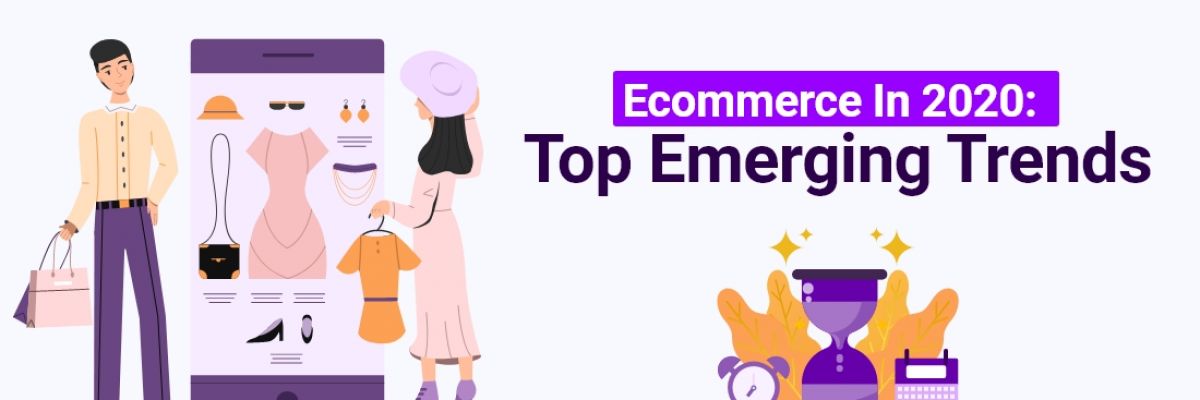Ecommerce in 2020: Top Emerging Trends You Need to Consider
Many new technologies and trends are emerging every day, which changes the way people shop. As an ecommerce business owner, if you want to succeed in the retail industry, you have to acquaint yourself with new trends.
Are you wondering to know what are the emerging ecommerce trends that take your business to the next level? Let’s analyze the latest customer shopping trends and take a look into the revolutionary technologies to get an understanding of how it enhances the shopping experience in the digital world.
Emerging Trends in Ecommerce
1. Immersive Commerce
Mostly, virtual reality (VR) and augmented reality (AR) is used in gaming or learning applications.
AR provides an immersive experience during shopping, which lets the customers choose the product from a virtual physical store (similar feel of shopping at a physical store but from home).
It allows the customer to preview the product in different aspects such as color or style. They use the cameras of your smartphone to provide a view of the real world and add digital information like text or images on the top of the view.
Virtual reality projects the images or video of a product like you are viewing them in 3D. It allows the user to see in all possible angles and provides a better perspective of the product with a 360-degree product view. That is, you can move around and look in every direction as you were present physically there.
Both AR and VR change the way the customers look into your store and provides them with great user experience. These technologies are slightly expensive to use now and, in some cases, they may be inappropriate.
2. Voice Commerce
According to research reports, in 2020, almost 50% of internet searches will be done using voice search.
Most of the customers use any one of the virtual assistants from Google, Amazon or Microsoft to conduct a voice search when using their smart devices.
It is an alternative for using a keyboard or screen to purchase products online. It is not only finding the product that you want but also helps in ordering and buying the same product.
Making a way to purchase the product easier, faster, and at any time made the voice search an essential feature in ecommerce. Features of the voice search are:
- Hands-free user interface for faster and easier shopping
- Answer all the user queries instantly
- Paves the way to buy products while doing other things as well.
Making smart devices to understand natural language and process them are the challenges this technology is facing today.
3. Social Commerce
Social commerce is buying the product directly from social media. That is, you can eliminate the links that direct to your website and make your customers complete the purchase on social media itself.
For example, anyone can search, enquire, and place the order directly on social media like Facebook, etc. It combines both social media and ecommerce to offer these benefits:
- Increase customer trust and grow your user base.
- Smooth checkout process when compared to the traditional ecommerce.
- Users can easily recommend products to others
Meesho is one of the best examples of social commerce and it is performing well across India.
4. AI and Machine Learning
Machine learning provides an ecommerce system to automatically learn and improve from customers’ behaviours automatically.
Ecommerce uses various personal data of the user for different purposes like personalization, payment details or delivery details. Since it handles huge data so it's difficult to check for inconsistency.
You can automate the anomaly detection with the help of machine learning technology. You can make use of multivariate statistical analysis and artificial neural network for detecting the fraud user action which raises suspicions.
Some errors like missing product images and incomplete product description which result in irrelevant product display can be quickly sorted with the help of machine learning.
5. Chatbots
A chatbot is an artificial intelligence that simulates communication with a user in a natural language through websites, mobile apps, telephone or messaging applications.
According to the grand view research report, the global Chatbot market is expected to reach $1.23 billion in 2025, with an annual growth of 24%. Already, 80% of businesses are using or planned to use chatbot by 2020.
Chatbots for ecommerce is designed to:
- Guide a customer during the purchase.
- Offer product recommendation as per the buyers' interest.
- Provide 24/7 customer support.
The major problem with the chatbot is, it only provides information to the customer with the pre-programmed data. It fails when a user's requests or queries are out-of-the-box.
6. Beacons
A beacon is a wireless transmitter that uses low-energy Bluetooth technology (BLE) to send signals to other nearby smart devices. It can deliver promotional messages through wireless communication.
But the question is how to use the beacon for your ecommerce business. Here are some ways:
- Sending welcome offers when a user is in a public place like traffic signals, shopping malls or in a cinema hall
- Sharing links regarding advertisements and offers
- Collecting data from various channels to bridge the gap between them and suggest relevant products
- Beacons help to wake up the app if it's not running
A major problem with beacon is, it is not secure and cost-efficient to leverage it for your business.
7. Ecommerce Product Videos
According to a study conducted by Brightcove, 46% of consumers have purchased an item by watching a product description video.
A video gives a better understanding of the product and increases the customers' trust. Some videos demonstrate how to use the product along with a detailed product catalog urging the users to make a purchase.
Interactive video gives the user the ability to interact while watching the video through various activities like click, drag, hover or scroll. This also provides a way for website owners to track the conversion and completion rates.
Interactive makes the viewers be part of your video which helps to analysis the user activities. They are time-consuming to create than images and requires specialized technology and more in-depth editing.
8. Snapchat Collection Ads
Snapchat is a growing social media with more than 200 million users and people use at least 25 times every day. Snapchat collection Ads are full-screen ads on Snapchat in video format. They play with sound and 100% in-frame ads.
You can upload product catalogs to Snapchat to create various ad formats that are more specific. The ads should target Snapchat users who use the site based on the website they visited.
Snapchat Ads is a low-cost marketing strategy and it can be easily implemented by any ecommerce business.
The Next-gen Ecommerce Platform
Apart from these, there are other ecommerce trends like Progressive Web Apps (PWA), omnichannel personalization, etc, that are already well-adopted by the online retail industry. But the trends and technologies discussed here change the way how people communicate, interact, search and buy for products, and make payments.
They provide various opportunities for ecommerce store owners to interact with their customers in innovative ways to make enjoy shopping online. In 2020, ecommerce will be more automated with the help of next-gen ecommerce platform to enable wonderful retail experience for both sellers and buyers.









